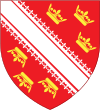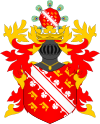European Collectivity of Alsace
European Collectivity of Alsace Collectivité européenne d'Alsace (fr) | |
|---|---|
 | |
| Status | Collectivity of the French Republic |
| Capital and largest city | Strasbourg 48°35′N 7°45′E / 48.583°N 7.750°E |
| Official language | French |
| Regional languages | Alsatian Welche Meridional Frankish Rhine Frankish |
| Demonym(s) | Alsatian |
| Government | |
• President of the departmental council | Frédéric Bierry[1] |
| Legislature | Departmental Council of Alsace |
| Establishment | |
• Creation | 1 January 2021[2] |
| Area | |
• Total | 8,280 km2 (3,200 sq mi) |
| Population | |
• 2020 estimate | 1,895,811[3] |
• 2017 census | 1,889,589[4][5] |
| ISO 3166 code | FR-A |
The European Collectivity of Alsace (Template:Lang-fr; Template:Lang-gsw-als; Template:Lang-de[6]) is a territorial collectivity in the Alsace region of France. On 1 January 2021, the departments of Bas-Rhin and Haut-Rhin merged into a territorial collectivity but remained part of the region Grand-Est. The creation of this new entity was voted by the French Parliament on 25 July 2019 and Law 2019-816 delimiting its powers was promulgated on 2 August 2019.[2][7]
Alsatian voters had already voted in favour of the creation of a single territorial collectivity in a referendum in 2013; however, in the less populous of the two departments, Haut-Rhin, a majority of voters had rejected the proposal.[8]
History
The original Region of Alsace, created in 1956, ceased to exist on 1 January 2016 when the French parliament voted to merge some administrative regions, reducing their number from 22 to 18.[9]
Status
Alsace has an intermediary status: its competencies are the ones of a department, plus some of a region. Alsace is therefore less autonomous than Corsica or the overseas departments and regions.
Languages
While French is the sole official language of the country according to Article 2 of the Constitution of France, Law 2019-816 contains provisions to promote regional languages at school. The collectivity will also be tasked to create a Committee related to the German language in Alsace. This last provision is closely related to Chapter 3 and Chapter 4 of the Aachen Treaty.
References
- ^ https://www.alsace.eu/actualites/resultat-l-election-president-collectivite-europeenne-d-alsace/
- ^ a b Government of the French Republic (2 August 2019). "LOI n° 2019-816 du 2 août 2019 relative aux compétences de la Collectivité européenne d'Alsace". legifrance.gouv.fr (in French). Retrieved 15 January 2020.
- ^ National Institute of Statistics and Economic Studies (14 January 2020). "Estimation de la population au 1ᵉʳ janvier 2020". insee.fr (in French). Retrieved 15 January 2020.
- ^ Combined 2017 population of the departements of Bas-Rhin and Haut-Rhin.
- ^ National Institute of Statistics and Economic Studies (30 December 2019). "Populations légales des départements en 2017". insee.fr (in French). Retrieved 15 January 2020.
- ^ "Aus zwei mach eins". Eurojournalist(e) (in German). 2019-06-26. Retrieved 2020-10-26.
- ^ "The government validates the creation of a "European collectivity of Alsace" in 2021". Teller Report. 29 October 2018. Retrieved 15 January 2020.
- ^ "Echec du référendum alsacien : "Un signe fort pour la classe politique en place"". Le Monde (in French). 7 April 2013. Retrieved 15 January 2020.
- ^ "Le 1er janvier, la France passe à 13 régions en métropole". Le Point (in French). 30 December 2015. Retrieved 15 January 2020.



